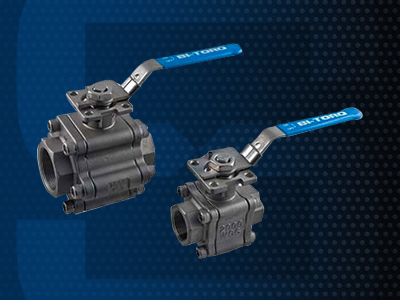Blog
2-pc or 3-pc Ball Valves?
April 27, 2020

Just as there are preferences between lug or wafer type butterfly valves, 2-pc and 3-pc ball valves also have their sides. We’ll look at some of the crucial factors to consider when deciding between the two types.
Factors that will be covered:
- Design
- End connections
- Installation
- Performance
- Ease of maintenance
Design
As the name implies, a 2-pc ball valve has two distinct pieces – one piece is an end connection and the body and a second piece, which has the other end connection as well as the valve trim.
A 3-pc ball valve has three body pieces – 2 ends and a center section that holds the valve trim. The three parts are bolted together around the three sections. Depending on the design, the bolts can be two ways – an enclosed type (bolts encased in sections) or around the body and ends (exposed). High-performance models tend to be of the latter variety. Due to the added complexity of the two end pieces and the body bolts, the design carries more weight with it.
End Connections
2-piece ball valves are, due to their design, limited in the type of end connection that it can have. They are typically limited to threaded end connections.
3-pc ball valves with their swing-out design, allow for welded end connections, so socket and butt weld ends are generally available.
Installation
Their simple design has made the 2-pc ball valves one of the most common types in a lot of industries. Due to this simple design, 2-pc ball valves are a lightweight solution for manual and automated fluid or gas control.
The 3-pc type is also very straight forward with its installation when the end connections are threaded. When welded ends are required, the unit, to prevent heat damage to the seat and seals, is partially disassembled during the installation of the end sections.
Performance
The simplistic design of having only two pieces of a valve to flow through allows for the 2-pc valve to have, generally, a better Cv value. The other differences in performance are more dependent on the seats, seals, and applications than the design type.
Ease of Maintenance
The swing-out design of a 3-pc valve allows for the end pieces to stay in place while the body section swings up and out of the line for cleaning or repair. This feature makes the 3-pc stand out against the 2-pc, whose design does not allow for any repair. Applications with thick or clingy media or where the lines must be clean out between batches are almost exclusively the home of 3-pc valves.
Summary
Based on the information above, the decision on whether to use a 2-pc or 3-pc must include a variety of factors, including media going through it, flow, line length for weight, and maintenance plans. The good news is that our technical sales staff will be more than happy to discuss such factors so you can make the right decision.
Learn More
BI-TORQ Valve Automation has served countless industrial, commercial, and municipal clients for over 35 years. Since our valve automation department began operations over 23 years ago, we have supplied thousands of ball and butterfly valves, electric and pneumatic actuators, automation accessories, and thermal shut-off valves to customers worldwide.
We are proud members of the Valve Manufacturers Association of America (VMA), and our proficient technical team is well-versed in valve actuators of all types. Our 25,000-square-foot manufacturing facilities allow us to operate efficiently to meet even the strictest client requirements without compromising quality or service.
If you would like to know more about our valve actuators, services, or other products, please contact us or request a quote.
